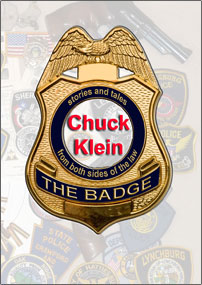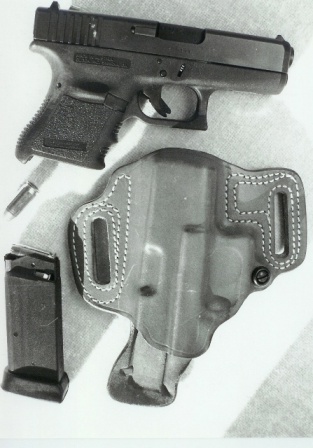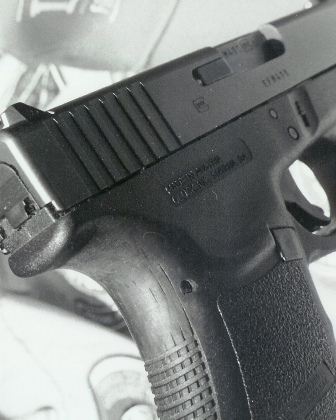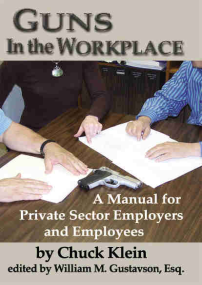FIREARM TESTS:
GLOCK: THERE'S A REASON THEY'RE SO POPULAR
Chuck Klein © 2002
(Published in GunWeek Magazine, 22 July 02)
In my capacities as a Licensed Private Investigator and former police officer, I have carried a concealed firearm - on or off the job - where ever I've gone for over 30 years. Though I've never shot anyone, I, like most of us in these professions, have had to "use" a handgun to save my own hide - on more than one occasion.
CARRY CRITERIA:
.jpg) There are a lot of "cute" or heavy-on-the-bells-and-whistles guns out there, but when you carry for survival - all day, every day - there are only three things that matter: Weight, Reliability and Fit. Aside from being uncomfortable, a carry-gun too heavy for your frame, will cause a loss of concentration when having to shift the gun's position or compensate for the discomfort in other ways. As an investigator, losing focus during a critical time could not only jeopardize the case, but my life as well. Reliability, goes without saying. Most (not all) modern guns from any of the major manufacturers are very reliable. Reliability, also includes stopping power inasmuch as a self-defense gun, even if it functioned with every pull of the trigger, would be of little use if it were of such a lessor caliber that it couldn't be counted on for stopping a lethal force assault.
There are a lot of "cute" or heavy-on-the-bells-and-whistles guns out there, but when you carry for survival - all day, every day - there are only three things that matter: Weight, Reliability and Fit. Aside from being uncomfortable, a carry-gun too heavy for your frame, will cause a loss of concentration when having to shift the gun's position or compensate for the discomfort in other ways. As an investigator, losing focus during a critical time could not only jeopardize the case, but my life as well. Reliability, goes without saying. Most (not all) modern guns from any of the major manufacturers are very reliable. Reliability, also includes stopping power inasmuch as a self-defense gun, even if it functioned with every pull of the trigger, would be of little use if it were of such a lessor caliber that it couldn't be counted on for stopping a lethal force assault.
Fit takes in proper holster to body compatibility as well as fit to the eye/hand. The goal of a defensive arm is one that will go from concealed carry to placing center body hits - BEFORE being incapacitated by your assailant. Any firearm relied upon for self-defense must come into battery pointing at the target without readjusting the grip or lining up the sights. If your eyes are looking at the target that is where the gun should be pointing after the draw. You should be able to draw your gun and hit a 12" square at seven yards without using your sights or changing your grip regardless of whether the target is in front, behind, or to your side.
I've known for a long time that the Glock series of pistols were very popular - especially with the police. But, I've resisted securing one for testing and evaluation because, well, I hate to be a follower, it might be just a fad and...I'm a wheel- gun-man at heart.
Fate intervened. During a training session at Tactical Defense Institute, (West Union, Ohio, www.tdiohio.com) where I teach my speciality, Instinct Combat Shooting (www.chuckkleinauthor.com/ics.html), I was offered a chance to shoot a fellow instructor's Glock. It was love at first shot!
 Most of the instructors carry Glocks and I was always a standout with my Dan Wesson .357, Model 15. This revolver never put me to a disadvantage as I could, even at my advanced age (60), match the other instructors, to wit: The 3- shot/3-target timed fire exercise. Here, a timer is held to the hearing protector of the shooter. Upon hearing the starting tone, the shooter must, from the chest ready position, react and then shoot three times at three different targets (all 21 feet distance). The goal is to do it in under one second. Very few can - most of the instructors being in the 1.5 second range. My best - with the revolver - was 1.08. Most students, by the time they complete level 5 of the TDI course, shoot in under 2 second range.
Most of the instructors carry Glocks and I was always a standout with my Dan Wesson .357, Model 15. This revolver never put me to a disadvantage as I could, even at my advanced age (60), match the other instructors, to wit: The 3- shot/3-target timed fire exercise. Here, a timer is held to the hearing protector of the shooter. Upon hearing the starting tone, the shooter must, from the chest ready position, react and then shoot three times at three different targets (all 21 feet distance). The goal is to do it in under one second. Very few can - most of the instructors being in the 1.5 second range. My best - with the revolver - was 1.08. Most students, by the time they complete level 5 of the TDI course, shoot in under 2 second range.
Though I haven't had the opportunity to test my skill and reaction time on the 3-shot trial with the Glock, there is no doubt, after some 600 rounds of practice, plinking and analyzing, I will be most competitive. For test ammunition, I used Hornady 185gr JHP/XTP because of my past experience with their uniformity and accuracy. There were no miss-feeds, jams or malfunctions of any kind throughout the testing.
Most manufacturers allow writers to purchase the supplied test weapon (a used gun - after the testing) at a significant discount. I can't keep all the guns I test due to space and money constraints, but this one's a keeper and is fast becoming a main carry piece.
HISTORICAL NOTES:
The Glock system was developed by Gaston Glock, circa 1980, for the Austrian Army. Being in a country that is short of steel mills, they were looking for a firearm that could be produced with non-strategic materials - such as polymer. The Glock Model 17, in 9mm Luger, was the result. In 1984 the pistol surpassed all NATO durability and strength standards and has now been accepted as the issue arm of many other nations.
 Glock, Inc. USA, was formed in 1990 to service the huge demand of American police and sport shooters. Today, Glock offers 15 basic models in three sizes (full, compact, sub-compact) in calibers of 9x19, .40, .357 Sig, 10mm, .45 ACP. Options include: compensated barrels, adjustable sights, Trijicom night sights and Meprolight night sights. Retail prices range from $641.00 (M17) to $700.00 (M36).
Glock, Inc. USA, was formed in 1990 to service the huge demand of American police and sport shooters. Today, Glock offers 15 basic models in three sizes (full, compact, sub-compact) in calibers of 9x19, .40, .357 Sig, 10mm, .45 ACP. Options include: compensated barrels, adjustable sights, Trijicom night sights and Meprolight night sights. Retail prices range from $641.00 (M17) to $700.00 (M36).
WHAT IS A GLOCK?
.jpg) Aside from it's polymer frame, which is fitted with treated steel slide rails, it is the 'safe-action' firing system that makes it mechanically unique. This double-action-only trigger system offers the distinct benefits of optional trigger pulls. Most DAO pistols have only one setup: long and hard. I set my sample to a 5.5 pound trigger pull with only a 3/8" distance. By way of comparison, my SIG Sauer P230 has a 8 pound pull of 1.2" and my AMT Backup is at 9 pounds and 3/4" distance. The AMT and the SIG, like most other semi-autos, do not have adjustable triggers.
Aside from it's polymer frame, which is fitted with treated steel slide rails, it is the 'safe-action' firing system that makes it mechanically unique. This double-action-only trigger system offers the distinct benefits of optional trigger pulls. Most DAO pistols have only one setup: long and hard. I set my sample to a 5.5 pound trigger pull with only a 3/8" distance. By way of comparison, my SIG Sauer P230 has a 8 pound pull of 1.2" and my AMT Backup is at 9 pounds and 3/4" distance. The AMT and the SIG, like most other semi-autos, do not have adjustable triggers.
Light short trigger pulls are nothing new - on single action pistols where manual safeties are incorporated into the design. Manual safeties combined with a single action function can be a detriment inasmuch as manipulating the safety takes time/thought/dexterity. A weapon with less than a 3 pound trigger pull (common for SA pistols) might be subject to accidental discharge. However, the Glock utilizes three independent and automatic safeties; one to control the trigger, one to secure the firing pin and an enertial safety to guard agains a dropped (or severely jarred) weapon. There are no manual safeties - levers, switches or buttons to manipulate - just pull the trigger.
WHY IS IT SO POPULAR:
Three words: Simplicity, Ergonomics, Reliability. Simplicity of design and function. Here the designers used only 34 parts. With fewer parts to malfunction or break, the reliability factor is enhanced. GLOCKs work - period. On the range at TDI, and aside from occasional ammunition (reloads) failure, there were virtually no malfunctions of GLOCK pistols - mine, other instructors or students. The pistol (and, as an aforementioned wheel-gun-man, I hate saying this) is as reliable as a revolver.

Ergonomically the gun just plain fits. With it's ambidextrous finger groves, thumb lock and trigger-finger indent to its 108 degree grip angle this gun shoots where it points and points where you look.
|
Additionally, and probably the most important feature is the combination frame/grip. Being made of polymer it is very easy to file and sand slight changes to the finger placement. My fingers are on the short side of normal, but I had no problem mating the Model 36 to my hand by removing about a 1/16" from the backstrap (see photo) and elongating the trigger finger grove on the right side. I chose the Model 36 (single stack, .45 ACP) over other models because double stacks are too wide for my hand and .45 ACP is a proven assault stopper.
For more information contact your dealer or:
GLOCK, USA
6000 Highlands Parkway
Smyrna, GA 30082
770/432-1202
www.glock.com
____________________________________________________________________________________________________________________________________
LASER SIGHT TEST
by Firearms Editor Chuck Klein © 2005
From P. I. MAGAZINE (Fall 1997)
LASER SIGHTS THAT WORK:
With the help of prime-time TV dramas, LASER sighting devices have captured the police and public's imagination. Made-for-TV movies have depicted police counter-snipers at great distances imprinting a tiny red dot on the chest of the bad guy, who, with a look of horror, immediately surrenders. In a true case of life imitating art, there are many documented arrests where a perp immediately capitulated after seeing the police-activated red dot imprinted on his chest.
The term "LASER" is an acronym for "Light Amplification by Stimulated Emission of Radiation." The early LASER sights were cumbersome and heavy devices that require the services of a qualified gunsmith for installation. Today, thanks to a Portland, Oregon, manufacturer, the user-friendly LASER sights are as easy to install as a new set of handgrips.
Unlike some other makers, the Crimson Trace units do not require a special holster to accommodate obtrusions, wiring of any type or unique skills or installation tools. Crimson Trace builds their LASER sights into the gun grips.
This innovative design allows the user to merely change grips (one screw on most guns) to add LASER sighting capability. The genius of the CTC LASERGRIPS is that the LASER light switch and adjustment screws are all incorporated into a set of hard plastic grips, molded to fit each specific firearm. The switch is found on the front portion of the grip directly where the middle finger comes to rest. With a normal handhold the middle finger activates the switch, which emits a bright red/orange beam from the right side of the grip to just above the trigger finger.
 Regardless of the make of LASER sight manufacturer, LASERs are accurate, cool, neat, fun and of some benefit to the user. However, they are NOT a panacea. They are not a substitute for proper trigger management or any of the fundamentals of handgun shooting. If you tend to jerk the trigger or have trouble holding steady, LASER sights won't improve your scores. But, if you are a practiced shooter, LASER sights, under certain conditions, can dramatically improve your hit ratio. The key words, "certain conditions," include ambient light less than direct sunshine; distances between 7 yards and 25 yards; and proper sight adjustment.
Regardless of the make of LASER sight manufacturer, LASERs are accurate, cool, neat, fun and of some benefit to the user. However, they are NOT a panacea. They are not a substitute for proper trigger management or any of the fundamentals of handgun shooting. If you tend to jerk the trigger or have trouble holding steady, LASER sights won't improve your scores. But, if you are a practiced shooter, LASER sights, under certain conditions, can dramatically improve your hit ratio. The key words, "certain conditions," include ambient light less than direct sunshine; distances between 7 yards and 25 yards; and proper sight adjustment.
A number of police and sheriffs agencies have reported successful arrest/confrontations after installing the CTC LASERGRIP on their service weapons. Police work, unlike private investigator's duties, involve physically arresting and detaining law breakers. Most of the success reported by the law officers are reports of how the arrestee meekly surrendered after seeing the LASER beam reflecting off his own chest. Since P.I's use of a firearm are for defensive purposes, the intimidation factor is of limited value.
With a hefty price tag, one has to wonder why such a small and lightweight product costs so much when LASER pointers and other LASER sights cost as little as $20. The reasons are found in the lens. CTC uses very precision ground glass - not plastic which is prone to damage from dirt and gun cleaning solvents. Glass also resists distortion due to temperature changes. Lens grinding is what makes the difference between a child's toy binoculars and a Leupold rifle scope or a Nikkon camera lens.
One concern of any battery-powered product is the cost and availability of the battery. Though the lithium battery is touted to have up to a 5-year shelf life and 4-6 hours of on-time service, CTC recommends changing the power source - and cleaning the terminals - every six months. Some LASER sighting devices have been designed to use very expensive "hearing aid" batteries or special batteries available only from the manufacturer. A check with a local camera shop. found a ready supply of CTC's power source, the common photo battery, Duracell #2032, at $2.50 each (two required).
Combined with tactical and psychological advantages, Crimson Trace's third-generation LASER sights are rapidly gaining acceptance in the police world. They are an excellent supplemental sighting device. Any pistol or revolver equipped with both tritium night sights and CTC LASERGRIPS could yield the ultimate handgun.
| SPECIFICATIONS: |
POSITIVE FACTORS OF CTC LASER GRIPS: |
NEGATIVE FACTORS OF LASER SIGHTED FIREARMS. |
|
* Retail selling price: $259 - $399
* Power output: <5 mw. Class IlIa
Visible LASER Diode. (Not hazardous to the eyes during momentary exposure)
* Wavelength/Beam Color: 633 nm / Red/Orange
* Beam size (claimed): .5" @ 50', round
* Beam size (tested): .375 x .625 @ 50';
.125x .250@21' oblong
* Battery: Duracell #2032, Lithium, 2.5 to 3.5 Vd
|
* Easy installation. No special tools or skills needed.
* Three year unconditional warranty.
* Simplicity of design. No wires or
activation switches.
* Excellent for training and to improve shooting skills.
* Great aid for those with diminished
eyesight due to age or other conditions.
* Special holsters not require.
* Best for low light conditions where iron sights are not readily distinguishable.
* Installing CTC LASERGRIPS will
not void handgun manufacturer's warranty.
|
* Habitually relying on their use could be a disadvantage under bright light conditions or during close-quarter combat.
* Having to hold lightly to keep from
activating switch means it is easier for assailant to knock weapon from hand.
* Bright LASER light could "give
position away" during low-light combat
situation.
* Right side mounted sight causes
parallax problems whereas, as
distance increases, point of impact moves left of line of sight.
* Extra time needed to "find"
LASER on target.
|
Is There Time?
The primary concern for any sighting device, including factory iron sights, is:
Does use of the sight require time for alignment/location? Some form of sight usage is recommended, except under close-quarter situations where Instinct Combat Shooting tactics are preferred (see:INSTINCT COMBAT SHOOTING by Chuck Klein and P.I. MAGAZINE, Spring, 1994 issue).
To test for any time difference between looking for the common iron sight picture against searching for a LASER dot, a set of Crimson Trace grips was given to John Benner, Chief Instructor at TACTICAL DEFENSE INSTITUTE TDI.com (see P.I. MAGAZINE Fall, 1997 issue).
Instructor Benner utilized a PACT timer for his tests (shooter draws on a beep sound, which starts the timer. The time stops on the sound of a gunshot.)
All shots were fired from 20' at a 10" circle. Firearm was J-Frame Smith & Wesson, Holster: Milt Sparks Summer Special IWB - strong side draw. Starting position was from hands held at chest high in defensive position. All times are average time in seconds.
Draw to I-hand hold, 5 rds, iron sights: 1.24
Draw to I-hand hold, 5 rds, CTC LASERGRIPS: 1.80
Draw to 2-hand hold, 10 rds, iron sights: 1.28
Draw to 2-hand hold, 10 rds, CTC LASERGRIPS: 1.8
Instructor Benner required slightly over a half-a-second more time to score hits by using LASER sights. This extra time might not be fatal at distances out to the limit of the weapon. However, at the test range of seven yards a half second could prove very costly in the heat of a real firefight.
For more information or to order contact:
CRIMSON TRACE CORPORATION
1433 N.W. Quimby Street
Portland, Oregon 97209
1-800/442-2406; FAX 1-503/295-2225
www.crimsontrace.com
____________________________________________________________________________________________________________________________________
KAHR ARMS FIELD TEST
by Firearms Editor Chuck Klein © 2005
From P. I. MAGAZINE (Summer 1996)
The first thing one notices about this new entry into the arena of compact defensive pistols is this semi-auto looks good. It looks, feels and handles like a quality piece of machinery. The second observation, this is a full 9mm Luger - not a .380 ACP!
 Machinery, or more precisely, machine tools is what KAHR ARMS (pronounced: car) is all about. Saeilo, Inc., a leading supplier of computer numerical control (CNC) machine tools, is the parent company. Established in 1981 Saeilo, Inc. formed a new division in 1986 to specialize in contract machining, aerospace, automotive, electronics and small arms manufacturing. KAHR ARMS headquarters and slide production is in Blauvelt, NY while frame, barrel and small components, along with assembly operations, are handled at the company's Worcester, Massachusetts facility. Even though each integral part is subjected to statistical process Control and computerized inspection, all firearms are test fired prior to shipments. Test ammunition is an assortment of commercial rounds including +P and +p+ cartridges. Saeilo,Inc. maintains an extensive machine tool distribution network and four manufacturing plants strategically located throughout the USA.
Machinery, or more precisely, machine tools is what KAHR ARMS (pronounced: car) is all about. Saeilo, Inc., a leading supplier of computer numerical control (CNC) machine tools, is the parent company. Established in 1981 Saeilo, Inc. formed a new division in 1986 to specialize in contract machining, aerospace, automotive, electronics and small arms manufacturing. KAHR ARMS headquarters and slide production is in Blauvelt, NY while frame, barrel and small components, along with assembly operations, are handled at the company's Worcester, Massachusetts facility. Even though each integral part is subjected to statistical process Control and computerized inspection, all firearms are test fired prior to shipments. Test ammunition is an assortment of commercial rounds including +P and +p+ cartridges. Saeilo,Inc. maintains an extensive machine tool distribution network and four manufacturing plants strategically located throughout the USA.
The KAHR, model K9, is a double-action-only (DAO) semi-auto design which means the hammer is cocked and released with each pull of the trigger. Subsequently, there are no user operated safety levers, buttons or controls that must be activated before firing. All that is required to discharge the pistol (after manually functioning the slide to charge the chamber) is to pull the trigger - just like any double action revolver. The trigger pull is long, with about half the distance in slack take-up, before actual resistance to the main spring is encountered. From the point of hammer engagement the trigger pull is smooth, light (about 7#) and sans any creep or drag. Under combat conditions - during rapid fire - the take-up is not noticeable.
Ergonomically, and that's what personal protection is all about, the weapon is second to none. Pointability, the ability of the gun to point to where the shooter is looking without any digital readjustment, is right on target. Unlikesome of the other compact handguns on the market, felt recoil, thanks to wrap around two-piece soft polymer grips, is negligible. Though the gun is touted (by some gun writers) as being a pocket pistol, this investigator believes any firearm with a weight of more than 18 ounces precludes carry in all but the bulkiest of top coat pockets. Locations of the magazine release and slide stop are placed for ease and comfort of the right hand shooter.
Though not intended to be a "target" pistol, the KAHR K9, aside from being fun to shoot, is very accurate for a short barreled pistol. The test gun in the hands of this investigator produced fist sized groups at the 25 yard range. At combat distances of seven yards, shooting out the "X" ring was within the compact's capabilities. Of the 100 or so Winchester 115 gr. FMJ and Dynamit Nobel FMJ rounds fired there were no malfunctions, miss-feeds or anything other than flawless performance.
If any negative can be found it has to be with the take-down procedure. Disassembling the pistol for cleaning requires practiced dexterity and plenty of physical strength. Because the recoil spring is on the heavy side, due to such a compact design, holding the slide back while trying to extract the slide stop is quite difficult. However, if one has the use of a leather padded vise the task is easy and simplified.
Concealability, to the Private Investigator who must work undercover or in situations that require the epitome of inconspicuousness of a weapon is tantamount to any successful operation. The slab-sided and protrusionless KAHR ARMS powerhouse, when mated to a secure and form-fitted holster, will please the most paranoid of agents. With a capacity of eight +p+ 9mm rounds and sans having a fumble with a manual safety the KARR K9 is excellent protection in today's increasingly violent society.
SUMMARY:
Functioning like a revolver, but without the bulk and limited capacity of a wheel-gun or a single action semi-auto with it's manual external safety, the DAO self-loader is here to stay. Some of the other compact 9's, both currently available and those that have gone out of business, are designed to have a limited life, are hard to shoot and/or don't point naturally. With it's many attributes, plus being manufactured from solid steel on CNC and CAD state-of-the-art machine tools, the KAHR K9 is destined to be a classic and to hold it's resale value. And, besides, it's American made.